Rolling Stone issue #12 had a cover date of June 22, 1968. 24 pages. 35 cents.
Features: “Dylan’s Basement Tape Should Be Released” by Jann Wenner; “A Special Report: Inside the Los Angeles Scene” by Jerry Hopkins (recently deceased); “Jagger Plans To Tour Again; New Stones Album Ready” by Bob Dawbarn; Ralph J. Gleason on Willie Mae Thornton; Ben Fong-Torres on Gordon Lightfoot; “Beatles Dump the Maharishi” by Our Correspondent.
News: Stones Announce New Single, Jagger Makes Acting Debut; Byrds Do the Country Thing; Fugs Celebrate Decency Week; KMPX Strikers Find a New Home; Buffalo Springfield Goes to Pasture; A Starting Film with Jimi Hendrix.
Columns: Perspectives by Ralph J. Gleason (“A Power To Change the World”); Visuals by Thomas Albright (“A Mind-Blown, Chaplinesque Mouse”); “John J. Rock” has some label news, a bitchy comment about the Rome Festival, and commentary about new songs from the Beatles (“‘Across the Universe,’ a Beatle song recorded at the same time as ‘Lady Madonna,’ was planned for release on an all-star Charity LP, but will probably not be released after all.”) and the Stones (“‘Jumping Jack Flash,’ a return to the riffs of ‘Route 66.'”).
Reviews: Lumpy Gravy by Frank Zappa on Verve (by Jim Miller); The Twain Shall Meet by Eric Burdon and the Animals on MGM (no byline); Pure Cotton by the James Cotton Blues Band on Verve Forecast (by Barry Gifford); Children of the Future by Steve Miller Band on Capitol (by Jann Wenner).
Notable Correspondence: Lenny Kaye (New York City) defends the honor of the Ronettes and the Shangri-Las; Bob Christgau (Secular Music, Esquire Magazine) defends Moby Grape.












